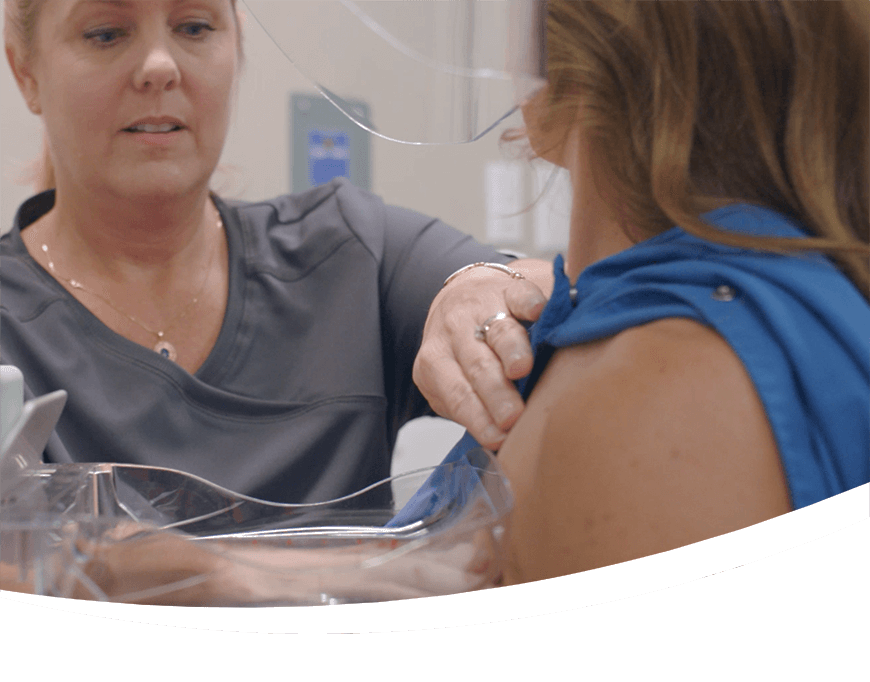Diagnostic Mammogram
A diagnostic mammogram is used to investigate suspicious breast changes, such as a new breast lump, dimpling or puckering of the skin, pain in the breast, or nipple thickening or discharge. A diagnostic mammogram includes additional targeted mammogram images used to evaluate the abnormal findings of a screening mammogram.

Call (866) 717-2551 to Schedule
Diagnostic mammograms require a physician’s order for scheduling. Please have your order ready when you call.
I truly can’t say enough good things about this place.
The facility is state of the art. 3-D Mammograms and interpretation by the Physician at the end of your visit...
The staff is caring, personable and professional. For those of us who know that “time is of the essence,” this is definitely where you want to be.
Kathryn, Patient
Unsure if your insurance is accepted?
While we accept most major insurance providers, we recommend verifying your coverage prior to your appointment. You may call your insurance provider, or our insurance and billing specialists can assist with verification. Call 469-398-4099 or email insuranceinfo@solismammo.com
Don't have insurance?
All of our centers offer self-pay pricing. Learn more by visiting our FAQ page or call our Insurance Hotline at (469) 398-4099 for more information.
On the day of your exam:
Wear a two-piece outfit. You will only need to remove your top and bra. We will provide you with a cape for your privacy and comfort.
Don’t apply deodorant prior to your exam. It can show up on images as white spots and cause an unnecessary return visit.
Please feel free to eat prior to your exam and to take any medications you're currently prescribed.
If you use an assistive device such as a cane or walker, you will be seated for your exam.
Please note:
If you were told to bring your order, please don't forget.
If you are a first time Solis Mammography patient and you have your prior records, please feel free to bring them.
If you have any questions prior to your appointment, please call us.
A diagnostic mammogram is performed if there is reason for further evaluation by a radiologist. Just as in screening mammography, diagnostic mammography uses 3D technology to produce detailed images of the breast.
Unlike a screening mammogram, a diagnostic mammogram captures targeted pictures of individual areas in the breast tissue, which warrant additional examination.
Coverage of diagnostic services may differ depending on your insurance provider. For questions about pricing and coverage, we recommend you call the Solis Mammography insurance and billing team at (469) 398-4099.
An order from your physician is required for all diagnostic services, including diagnostic mammograms, as a part of the continuum of care provided to you by Solis Mammography and your physician of record. Results of your diagnostic mammogram will be delivered to your physician, who will be an integral part of the diagnostic and, if needed, treatment process.
A diagnostic mammogram is similar to a screening mammogram with one main difference. During a screening mammogram the goal is to adequately capture images of tissue in both breasts. The goal of a diagnostic mammogram is to provide clarity around a targeted area, typically in a single breast, or as a follow up after surgery or a found abnormality. During a diagnostic mammogram you will have direct interaction with a breast radiologist.
You may be referred for a diagnostic mammogram as a follow up to a screening mammogram that resulted in inconclusive results or that identified an area of concern that warranted further evaluation. Women who have been previously diagnosed with breast cancer and those who are in need of short-interval follow ups may also be referred for a diagnostic mammogram. It is important to note that most diagnostic mammograms result in benign findings.
Reasons for a diagnostic mammogram include:
- Supplemental views to provide clarity around a specific area of breast tissue
- Visible abnormalities such as calcifications, cysts, fibrocystic tissue, dense tissue, fibroadenomas
- Short-term follow-up monitoring of abnormalities
- Follow-up imaging after breast cancer or the discovery of a high-risk lesion based on your surgeon’s recommendation
A diagnostic mammogram typically takes 15 to 30 minutes to capture targeted images of the breast. Appointments, which include both a diagnostic mammogram and an additional diagnostic procedure, such as a biopsy, may last longer.
While every woman’s breast tissue is different, there are important signs of breast cancer to be aware of. If you are experiencing one or more of these symptoms, contact your physician immediately for a referral. Many cancers have no symptoms at all, however, familiarity with your breasts will make it easier to identify changes.
Symptoms of breast cancer include:
- Lumps or nodules felt on or inside the breast
- Changes in the size or shape of the breast, or unusual swelling
- Nipple retraction or inversion
- Redness or rash on the breast
- Pain in the breast or nipple
- Dimpling of the breast (similar texture to an orange peel)
- Swelling of the lymph nodes, particularly around the collar bone and in the armpit. Irritated or itchy breasts, or flaking of the skin
- Increased breast size or shape in a short period of time
- Changes in touch (may feel hard, tender or warm)
- Nipple discharge (aside from breast milk) that ranges in color from clear to milky, yellow, green or red